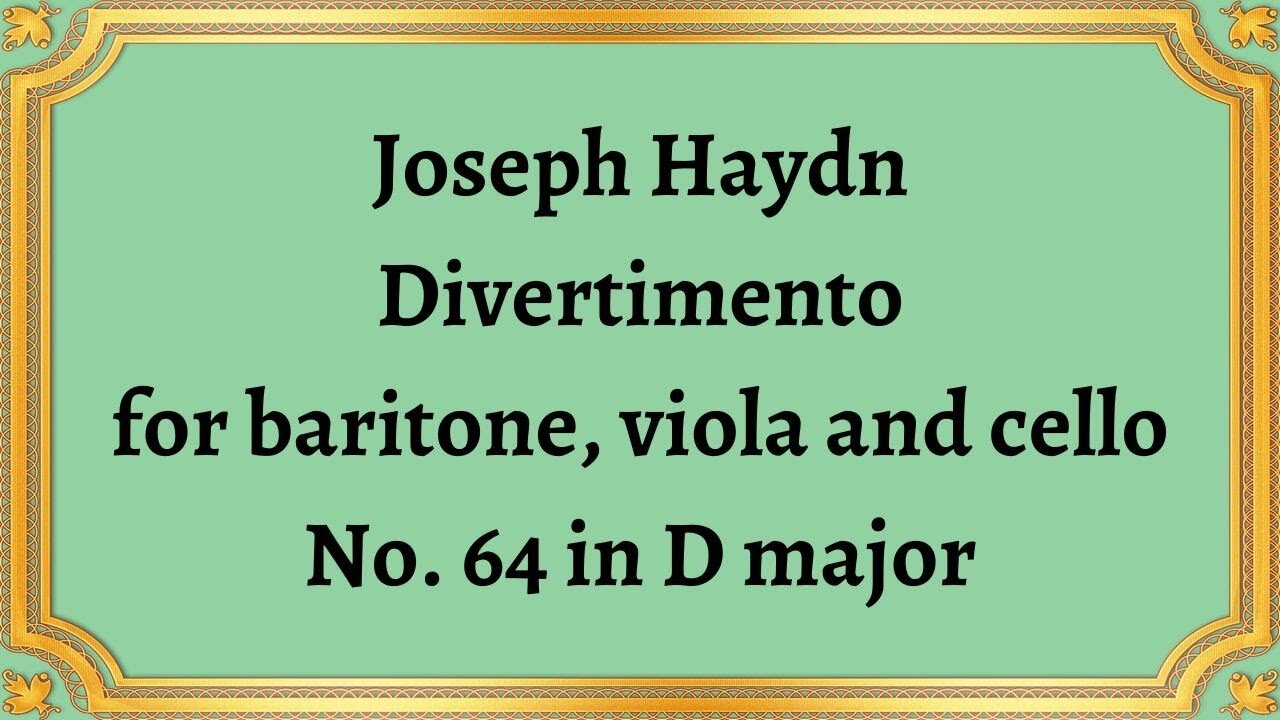Premium Only Content

Joseph Haydn Divertimento for baritone, viola and cello No. 64 in D major
#JosephHaydn #Divertimento #Baritone #Viola #Cello #Dmajor #chambermusic #Adagio #Menuetto #Allegro #classicalmusic #baryton #instrumentation #musiccomposition #ChamberMusicRepertoire
Joseph Haydn, one of the most renowned classical composers, wrote more than 100 divertimentos. The Divertimento for Baritone, Viola, and Cello No. 64 in D major stands out as a unique composition in the chamber music repertoire. It features a rare instrument, the baryton, which Haydn often used to create unique and complex melodies.
The Divertimento for Baritone, Viola, and Cello No. 64 in D major was composed in 1773 upon the request of Prince Nikolaus Esterhazy for his baryton-playing ensemble. The work's instrumentation includes baritone, viola, and cello. Unlike most of his compositions, Haydn used the unusual tuning of the baryton to create a rich tonal palette. The baryton has a set of wire strings on the back of the fingerboard, which when plucked by the left hand produce a unique sound that adds to the piece's texture.
The first movement of the Divertimento is marked as Adagio, which means slowly. The opening melody is played by the viola, interweaving with the cello and baritone in the background. The soaring, and at times, melancholic melody, creates an appreciable ambience. The second movement, marked as Menuetto, is in a 3/4 meter, with a more rhythmic and upbeat feel. As the name suggests, this movement presents a pleasant dance-like style. The trio section of the Menuetto is scored for the baritone and viola in a duet with the cello providing an accompaniment. The final movement, marked as Allegro, is the most technically demanding section of the Divertimento, with the baryton and viola carrying the melody, and the cello providing a rich harmonic foundation. Haydn's use of the baryton in this work is exceptional, as it produces a sound that is not found in any other chamber music composition.
Joseph Haydn's Divertimento for Baritone, Viola, and Cello No. 64 in D major is a significant contribution to the chamber music literature. The composer's ability to create a rich texture using a rarely heard instrument such as the baryton is evident in this composition. Haydn's music has endured centuries, and it's exciting to listen to how he blends the tones from different instruments, creating works that continue to enthrall audiences today.
You have the opportunity to support the channel https://destream.net/live/RadSiarAl/donate
-
 31:06
31:06
Classical music_Music Inspiration
23 days agoPyotr Ilyich Tchaikovsky Piano Concerto No. 1 in B-flat minor
541 -
 LIVE
LIVE
Law&Crime
2 hours agoLIVE: Adelson Matriarch Murder Trial — FL v. Donna Adelson — Day 1
238 watching -
 LIVE
LIVE
JuicyJohns
3 hours ago $0.07 earned🟢#1 REBIRTH PLAYER 10.2+ KD🟢
112 watching -
 59:26
59:26
Coin Stories with Natalie Brunell
6 hours agoWho's Selling Bitcoin? Preston Pysh on Bearish Sentiment, Bitcoin Treasury Warning Signs and Ponzis
60 -
 1:44:34
1:44:34
Dear America
2 hours agoGavin Newsom Is Trying To COPYCAT MAGA!? Newsom 2028 Incoming… + Troops Are Coming To FIX CHICAGO!!!
70.2K38 -
 LIVE
LIVE
Badlands Media
10 hours agoBadlands Daily: August 25, 2025
3,852 watching -
 35:18
35:18
The Quiet Part
3 hours agoMAID Is Coming for the Mentally Ill — But This Could Change Everything
4.15K -
 LIVE
LIVE
Surviving The Survivor: #BestGuests in True Crime
2 hours agoLIVE Court: Wendi Adelson Testifies Against Mom, Donna Adelson, in Dan Markel's Murder Trial
169 watching -
 1:14:57
1:14:57
JULIE GREEN MINISTRIES
4 hours agoRUSSIA IS ABOUT TO RELEASE SOMETHING THAT WILL CRUSH THE ESTABLISHMENT
92.1K203 -
 LIVE
LIVE
GritsGG
3 hours agoWin Streaking! Coloring Hair at End of Stream! Most Wins 3435+ 🧠
43 watching